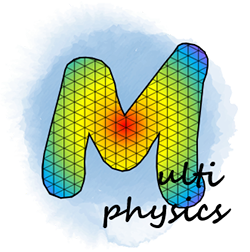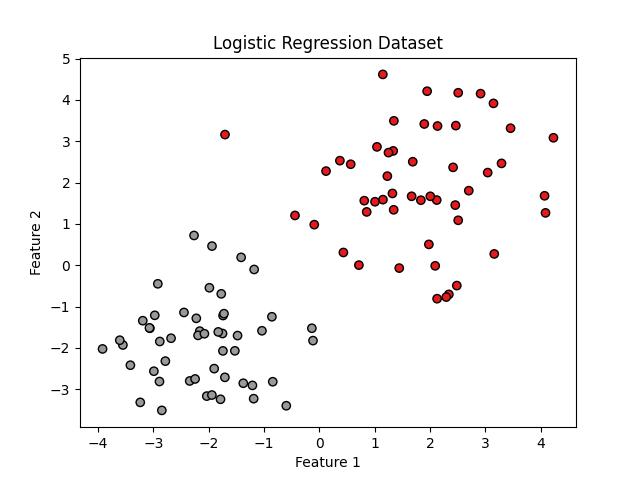 Logistic regression for classification
Logistic regression for classification
Beijing Institute of Technology | Ming-Jian Li
The following Python code is a companion code for the course on Artificial Intelligence and Simulation Science. It functions to establish a logistic regression model to classify the given data, with parameters optimized using the gradient descent method.
x
1import numpy as np2import matplotlib.pyplot as plt3
4# random seed5np.random.seed(42)6
7# mean value and covariance8mean_1 = [2, 2]9cov_1 = [[2, 0], [0, 2]]10mean_2 = [-2, -2]11cov_2 = [[1, 0], [0, 1]]12
13# generate samples 14X1 = np.random.multivariate_normal(mean_1, cov_1, 50)15y1 = np.zeros(50)16
17X2 = np.random.multivariate_normal(mean_2, cov_2, 50)18y2 = np.ones(50)19
20X = np.concatenate((X1, X2), axis=0)21y = np.concatenate((y1, y2))22
23plt.scatter(X[:, 0], X[:, 1], c=y, cmap=plt.cm.Set1, edgecolor='k')24plt.xlabel('Feature 1')25plt.ylabel('Feature 2')26plt.title('Logistic Regression Dataset')27plt.show()28
29def sigmoid(z):30 y = 1.0/(1.0+np.exp(-z))31 return y32
33class LogisticRegression:34 def __init__(self, learning_rate=0.01, num_iterations=1000):35 self.learning_rate = learning_rate36 self.num_iterations = num_iterations37 self.weights = None38 self.bias = None39
40 def fit(self, X, y):41 num_samples, num_features = X.shape42
43 # initialize44 self.weights = np.zeros(num_features)45 self.bias = 046
47 # gradient descent48 for _ in range(self.num_iterations):49 linear_model = np.dot(X, self.weights) + self.bias50 y_pred = sigmoid(linear_model)51
52 dw = (1 / num_samples) * np.dot(X.T, (y_pred - y))53 db = (1 / num_samples) * np.sum(y_pred - y)54
55 self.weights -= self.learning_rate * dw56 self.bias -= self.learning_rate * db57
58 def predict_prob(self, X):59 linear_model = np.dot(X, self.weights) + self.bias60 y_pred = sigmoid(linear_model)61 return y_pred62
63 def predict(self, X, threshold=0.5):64 y_pred_prob = self.predict_prob(X)65 y_pred = np.zeros_like(y_pred_prob)66 y_pred[y_pred_prob >= threshold] = 167 return y_pred68
69logreg = LogisticRegression()70
71logreg.fit(X, y)72
73X_new = np.array([[2.5, 2.5], [-6.0, -4.0]])74y_pred_prob = logreg.predict_prob(X_new)75y_pred = logreg.predict(X_new)76
77print("Predicted Labels:", y_pred)The dataset is as follows:

The classification results for the given two points [2.5, 2.5] and [-6.0, -4.0] are:
Predicted Labels: [0. 1.]